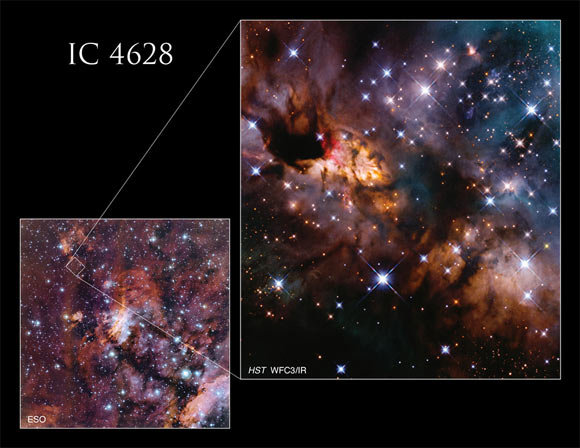The Hubble team has released a striking image captured by the NASA/ESA Hubble Space Telescope showing a small section of the Prawn Nebula (IC 4628).

This Hubble image shows the Prawn Nebula. Image credit: NASA / ESA / Hubble / J. Tan, Chalmers University of Technology / Gladys Kober, NASA & Catholic University of America.
The Prawn Nebula is a massive stellar nursery located approximately 6,000 light-years away in the constellation of Scorpius.
Astronomers classify it as an emission nebula, which means its gas has been energized, or ionized, by the radiation of nearby stars.
“The radiation from these massive stars strips electrons from the nebula’s hydrogen atoms,” the Hubble astronomers said.
“As the energized electrons revert from their higher-energy state to a lower-energy state by recombining with hydrogen nuclei, they emit energy in the form of light, causing the nebula’s gas to glow.”
“In this Hubble image, red indicates the presence of ionized iron (Fe II) emission.”

The Prawn Nebula lies south of the star Antares in the constellation of Scorpius. Image credit: NASA / ESA / Hubble / J. Tan, Chalmers University of Technology / ESO / Gladys Kober, NASA & Catholic University of America.
The Prawn Nebula is also known as Gum 56, after the Australian astronomer Colin Gum, who published a catalogue of HII regions in 1955.
“Though the nebula stretches 250 light-years and covers a space four times the size of the full moon, it emits light primarily in wavelengths the human eye cannot detect, making it extremely faint to earthbound viewers,” the researchers said.
“Hubble’s gaze, however, shows a small section of the nebula here in both visible and invisible infrared light, capturing dazzling detail of the nebula’s structure, including bright areas of glowing gas.”
“This image was captured as part of a survey of massive- and intermediate-size protostars,” they added.
“We used the infrared sensitivity of Hubble’s Wide Field Camera 3 (WFC3) to look for hydrogen ionized by ultraviolet light ionized by the protostars, jets from the stars, and other features.”







